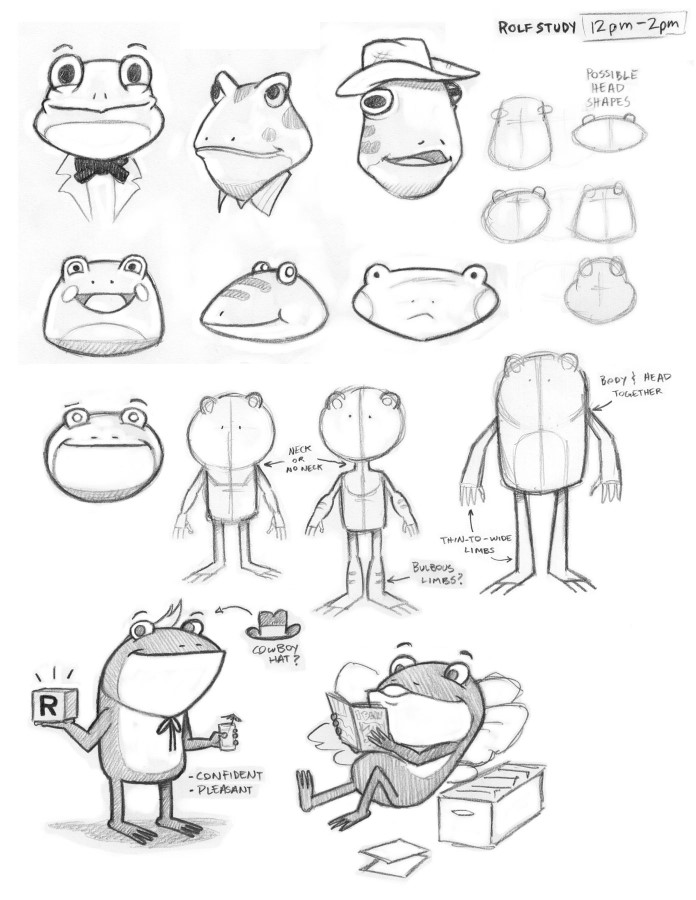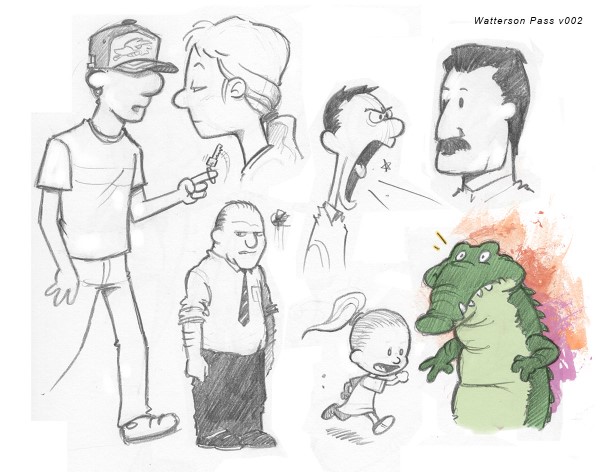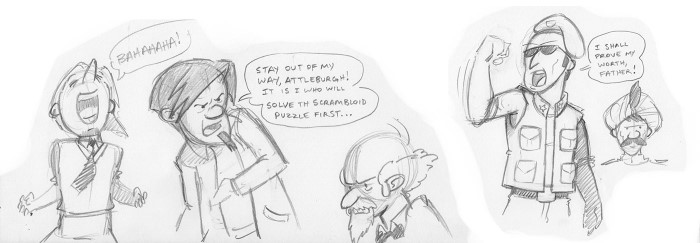In the beginning Alex wanted to see what I could do in terms of my own talents. When it came to creating things in my own style I thought about what sort of game Alex wanted to make, the audience he expected it to draw in, and of what he wanted to do with my artwork. So it basically came down to form, substance, and audience.

Scramble Legends, or “Scrambloid” as it was called back then, is a fast-paced word game with Scrabble and Tetris-like elements. Avatars were to be animated in some fashion so I tried to keep the design simpler in order to make animation easier down the road.
Alex and I brainstormed a bunch of avatar ideas using different categories to give me a solid basis for generating variety. We flung around typical ideas like animals, robots, and super heroes as well as some more esoteric ones like plants spirits, mythological heroes, and even these little pixie people called Wizzles that were “word wizards”.
I knew Scramble Legends was geared for a more female audience but wanted to find something that could suit almost all age groups. In the end we wound up having to add more female characters to cater to the female demographic, but still had a general cartoon cast and look that would also appeal to children and young adults.
Borrowing from Others
Before Alex and I made a decision, we thought it best to pull inspiration from other styles and cartoonists that might be fun and meet our needs. The thing about mimicking others’ work is that it shouldn’t be an exact copy, especially when you are getting paid for it. Other artists get miffed if you are making a profit off of something that took years to achieve. It’s also a simple matter of respect for the creative property of others. That being said, when I made the first styling passes for these I did my best to mimic them in order to prove that I could work in the style.
Next, I began to deviate from the style just enough to where it wasn’t a replica but still retained an influence from the source material. For instance, when I was drawing out a Bill Watterson style pass I took note of his unique line quality. If we were to use a Watterson influence, I wanted to make sure I nailed that thick and lively line from his ink work.

In the end we liked the Tintin style of Georges Remi (Herge) the best. It was easy to break his style down into simple shapes and retool it to make custom characters of my own with large amounts of variation.
Character Casting Call
Once the Tintin style was chosen, I went to work furiously making as many different characters as I could. In all I ended up making over 50 different characters. To help me get this plethora of personas I broke characters into age, gender, and cultural categories as well as sprinkling in other ethnicities to give me a sprawling diagram of what could be possible.
One thing I find helps to elaborate on certain characters is to invent a small back story. A character without a past is like a body without a soul, it’s the mechanism of personality within the design. As a result, my rough drafts would start with one thing and then end up somewhere completely different by the time the final asset was sent to Alex. This is why some sketches have characters saying something in word bubbles to encapsulate their backstory.

Putting on the Polish
After Alex and I had chosen nine characters we really liked, I began to focus on putting these character concepts through my finalization pipeline. By this point in the project, Alex and I had become more like partners rather than director/artist. Given time and money, we decided to cut a few features for launch, among them not fully animating the avatars and instead giving them four distinct reaction states. The pipeline went a little something like this:

For each of these steps I sent the results to Alex for his thoughts and approval. It was important to me that we were both content with what we had. In the beginning I started showing the characters in batches but once I began work on the reactionary states it became a per character affair.
At this stage generalization was not enough, each character needed tangible and visually refined elements and an individual flare. The avatars’ individuality came from:
- Their clothing and accessories It’s true, clothes do make the man or woman. I thought about occupation and lifestyle to determine what I’d do in terms of garments.
- Their hair styles How a person wears their hair can drastically change their appearance and reflect a little of their personality.
- Their reactionary states Even though expression is last on this list, it’s definitely not last in terms of importance. How a character reacts to comedy or tragedy or how they carry themselves speaks volumes on who they are.
Globe Trotting Development
The fact that Alex and I live nearly half a globe away (Alex in the Netherlands and I in California) gave us the challenge of syncing our development time together. When we were in the concepts phase I would wake up and read my Google Talk “wake-up call” from Alex on my phone. Typically, Alex would critique and give his thoughts on the previous day’s submissions. Next I would organize my thoughts on the matter, and then we would both decide on what new styles to tackle or expand on that day.
With sketchbook in hand, I biked my way to a local coffee house and got to work. Six hours of sketching later and it was back to my house to scan and touch up the sketches in Photoshop. Finally I would add all the day’s assets to our Dropbox folder along with a summary email ready for Alex’s review when he woke up. This process worked well throughout the project and became a rhythm we found easy to maintain.
One of the biggest things I believe Alex and I gained from developing Scramble Legends is that trust between artist and programmer is paramount. We had nine hours difference between us and worked while the other slept. It was a situation that had the potential to have many things go wrong and fall into dysfunction. But our constant dialog and understanding of each other’s role got us, and the game’s aesthetic, to finish line.

- User Interface: a look at how the user interface was designed
- Avatar Style: follow the evolution of Scramble Legends' art style
- Making the Avatars: guest post by Kyle McGill artist for Scramble Legends
- Avatar Design: learn how the avatar art style was finalized
- End Game Condition: explore the thought process behind the game's end game condition
- Attack Design: understand why Scramble Legends is all about burying your opponent
- Overdrive Mode: a look at the design and technical considerations behind this special game mode
- Sound Design: guest post by David Kizale sound designer for Scramble Legends

